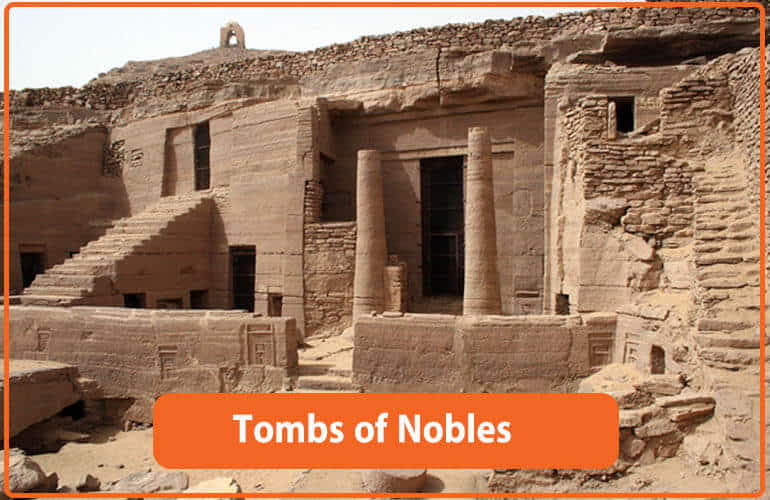Tombs Of The Nobles Facts:

The hills on the west bank of the Nile, north of Kitchener’s Island, are pock-marked with the rock-hewn Tombs of the Nobles. Dating from the Old and Middle Kingdoms, many of the tombs are decorated with scenes of everyday life.
The largest and best-preserved tomb is that of Prince Sarenput II, governor of southern Egypt during the 12th Dynasty. The burial chamber is decorated with statues of the prince and paintings of him and his son hunting and fishing.
The tombs of Mekhu, a noble from the 6th Dynasty who was murdered while on a military expedition in Nubia, and his son Sabni, are crudely decorated with funeral and family scenes.
The tomb of Prince Sarenput I, Guardian of the South during the 12th Dynasty, shows him with his family and dogs.
The ancient necropolis is lit up by spotlights at night and looks particularly magical when viewed from across the river in Aswan.
Top 10 Tombs of the Nobles:
1- Tomb of Sennefer
Sennefer was mayor of Thebes and overseer of the gardens at Amun under Amenhotep III. His is one of the best-preserved tombs, with a ceiling covered with brightly colored paintings of vines.
2- Tomb of Userhat
Userhat was one of Amenhotep II’s scribes. His tomb has detailed scenes of everyday life, including a trip to the barbers.
3- Tomb of Rekhmire
Rekhmire was a vizier under Tuthmosis III and Amenhotep II and his tomb depict him collecting taxes and receiving gifts from foreign lands. Among the tributes shown are vases from Crete and a giraffe and monkeys from Punt (present-day Somalia).
4- Tomb of Ramose
Ramose was a governor of Thebes around the time of Akhenaten’s Amarna revolution, when the pharaoh overthrew Egyptian polytheism in favor of the worship of a single god, Aten. This superb tomb is interesting for featuring both Classical and Amarna-style reliefs.
5- Khokha Tombs
This trio of tombs was built for New Kingdom officials. Discovered in 1915, they were opened to the public only in 1995. Their decoration is similar to the other tombs in this area.
6- Assasif Tombs
These are three more tombs that lie between the main Tombs of the Nobles and the Temple of Hatshepsut. Some of the Assasif tombs date from the Late Period, notably the Tomb of Pabasa, which has detailed bee-keeping and fruit-picking scenes.
7- Tomb of Benia
Benia was a supervisor of construction work. As with the other two tombs in this group, Benia’s tomb has paintings depicting vignettes of life, as well as statues of the deceased and both his parents.
8- Tomb of Khonsu
Khonsu was an advisor to Tuthmosis III. His tomb is painted with colourful scenes depicting the Festival of Montu.
9- Tomb of Menna
Menna was an inspector of estates. Paintings in his tomb depict him and his wife making offerings to the gods. A scene in the inner chamber also portrays him hunting and fishing.
10- Tomb of Nakht
This tomb is decorated with scenes of rural life, such as fishing, hunting, and harvesting, as well as a banqueting scene with dancers and a harpist. It is one of the most fascinating tombs with exceptionally vivid and lively paintings.
Book your Travel Package now to know more about Egypt history.






